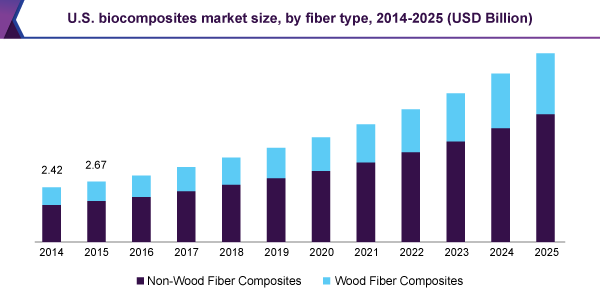25 Jun 2019 San Francisco; The global biocomposites market size is projected to reach USD 46.3 billion by 2025, according to a report by Grand View Research, Inc., exhibiting a 12.5% CAGR during the forecast period. Increasing use of biocomposites in end-use sectors such as automotive, building and construction, electrical and electronics, and consumer goods is the main driver triggering the biocomposites market. Additionally, changing consumer preference from plastic composites to ecofriendly biocomposites is expected to spur market growth over the forecast period.
Biocomposites are composite materials made from natural fiber such as wood or non-wood fiber, along with polymer resin. Their use in various sectors is increasing due to their eco-friendly characteristics. They are effectively being used as a substitute for plastic composites. Strict environment laws are also favoring their usage.
Use of biocomposites made from wood fiber is growing as an increasing number of forests are under systematic and sustainable utilization. Wood plastic composites are manufactured from wood fibers. Use of natural polymer is also increasing as a result of push for 100% biodegradable products. There is a significant demand for 100% biodegradable products in developed markets of North America and Europe.
The handling of plastic waste globally is a serious issue as plastic products do not decompose easily. In order to tackle this problem, a number of governments have banned plastic products and are promoting the use of biocomposites as a substitute for plastic composites. Furthermore, they are used as a substitute for metal and alloys in automotive nonstructural parts such as parcel shelves and interior panels. Use of biocomposites in the automotive sector is likely to help in decreasing the overall weight of a vehicle and also reduce instances of injuries to passengers in cases of accidents. Similarly, surging demand in electrical and consumer durables sectors is expected to drive the market.
Rising disposable income in developing countries such as China and India and growing awareness about biocomposites and their advantages are key factors expected to drive the market in the region. Ban on non-reusable plastics in Europe is driving demand in the region.
A number of key players in the industry are investing in research and development of eco-friendly and high strength products. Some players have also integrated their operations throughout the value chain in an attempt to increase profitability and serve customers better.

To request a sample copy of this report, click the link below:
www.grandviewresearch.com/industry-analysis/biocomposites-market
www.grandviewresearch.com/industry-analysis/biocomposites-market
Further key findings from the report suggest:
- By type of fiber, wood fiber composites are expected to grow at the fastest throughout the forecast period
- Transportation emerged as the largest end-use segment in the market, followed by building and construction
- Asia Pacific is expected to be the largest regional market for biocomposites. It is also likely to be the fastest-growing regional market over the forecast period.
Grand View Research has segmented the global biocomposites market on the basis of fiber type, polymer type, product type, end use, and region:
Biocomposites Fiber Type Outlook (Volume, Kilotons; Revenue, USD Billion, 2014 - 2025)
- Wood Fiber Composites
- Non-wood Fiber Composites
Biocomposites Polymer Type Outlook (Volume, Kilotons; Revenue, USD Billion, 2014 - 2025)
- Natural Polymer
- Synthetic Polymer
Biocomposites Product Type Outlook (Volume, Kilotons; Revenue, USD Billion, 2014 - 2025)
- Green Biocomposites
- Hybrid Biocomposites